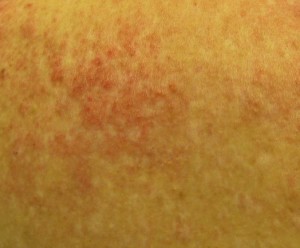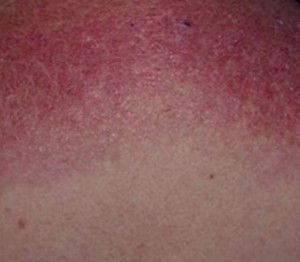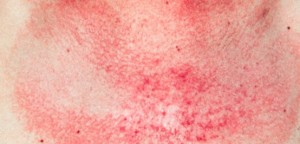Also known as heliotrope rash, dermatomyositis is an uncommon inflammatory disorder which causes muscular weakness and development of very noticeable rashes on skin. The condition is classified as a “chronic inflammatory myopathy” by doctors all over the world. This myopathy group consists of 3 types of disorders and dermatomyositis is regarded as one of the disorders.
Dermatomyositis rash can affect both children and adults. However, children in the age group of 5 to 15 years and adults in the age group of 45 to 65 years are at increased risk to developing the inflammatory rashes as compared to people belonging to other age groups. Women are also relatively more vulnerable to developing dermatomyositis rash than men.
It is possible for the symptoms of dermatomyositis to alleviate and clear out all of a sudden. However, such instances of remission tend to continue only for short periods of time. A variety of medications can help enhance muscle strength and functioning as well as help get rid of the anomalous rashes on skin.
Symptoms of dermatomyositis rash
- A dermatomyositis rash which develops on the skin tends to be red, violet, or brown in color. They may typically occur in clusters or patches and display bluish-purple blemishes. They are different from other kinds of skin rashes and is often the primary and initial symptom of dermatomyositis. The rashes tend to mainly affect the face and the eyelids. Sometimes, it may occur on the nails, knuckles, back, elbows, and the chest.
Other distinctive signs and symptoms that accompany an instance of dermatomyositis rash are listed below:
- There is continuous weakening of overall muscle strength and muscle weakness. It is the second most noticeable symptom of dermatomyositis. The muscles present next to the trunk, like the muscles of the upper arms, shoulders, hips, neck, and thighs are especially affected by increased weakness.
- There may be tenderness and pain of the affected muscles.
- Muscle weakness tends to occur in a balanced manner and slowly deteriorate. It may affect the right side of the body or the left side.
- Children with dermatomyositis rash are at increased to buildup of calcium deposits below the surface of the skin. They are also more prone to experience a variety of gastrointestinal problems such as intestinal ruptures and/or ulcer formation.
- Patients may also suffer from fatigue, exhaustion, fever, and reductions in weight.
- Weakness of the muscles may result in some form of difficulties in swallowing.
Complications
A case of dermatomyositis rash may result in the below listed health complications:
- Elevated vulnerability to occurrence of varied illnesses
- The development of dermatomyositis rash in expectant women can result in varied complications of pregnancy such as premature delivery, and stillborn child, etc. These health problems may not occur if dermatomyositis is in a phase of remission.
- There is increased risk to development of connective tissue anomalies such as Sjogren’s syndrome, rheumatoid arthritis, lupus, and scleroderma.
- There is increased risk to development of cancers of different organs, especially malignancy of the cervix, lungs, breasts, bowels, and ovaries.
- Individuals suffering from dermatomyositis rash may also be prone to developing interstitial lung disease. It is a group of pulmonary disorders that causes scarring or the lung tissue or fibrosis. Patients may elicit a variety of adverse respiratory symptoms including stiffness of the lungs, lowered elasticity of the lungs, dry coughing, and breathlessness, etc.
- There is increased risk to development of diverse cardiovascular ailments such as myocarditis, inflammation of the heart muscles, congestive heart failure, and arrhythmia, etc.
- There is increased risk to development of a condition known as Raynaud’s phenomenon. This condition affects the extremities of the body and causes them to become discolored after contact with cold environments. The cheeks, nose, ears, and fingers tend to become number and discolored.
- Complications caused due to abnormalities of the muscles
- Weakened muscles of the esophagus may pose problems in swallowing. Patients may also suffer from dysphagia. Eventually, in the long run, affected people may suffer from deficits in nutrition and loss of weight.
- If dermatomyositis rash affects older adults, then accompanying weakness of the muscles in and around the torso can aggravate varied age-related problems such as gastrointestinal bleeding, formation of ulcers, and other gastrointestinal system irregularities.
- Problems in swallowing may have an adverse effect on the respiratory system. Patients may thus be at increased to developing aspiration pneumonia, which may be accompanied by varied symptoms such as aspiration of food matter, liquids, and/or saliva. This in turn can trigger the onset of other respiratory ailments.
- Weakening of the muscles in the chest area may cause shortness of breath and other breathing problems.
- Complications caused due to rash and other skin abnormalities
- The gradual worsening of dermatomyositis over a period of time may trigger the accumulation of excess calcium in the muscles, skin, and connective tissues. These hard calcium deposits are especially prevalent in children and also develop a lot more quickly.
- Patients may scratch the rashes to alleviate the itching. This is tear the skin; resultant wounds are then prone to developing secondary bacterial infections.
- The respiratory and digestive systems are at increased risk to developing varied types of infections.
Causes
Dermatomyositis rash has been classified as an autoimmune disorder by the medical fraternity. The causes of the condition are however not known.
As is the case with autoimmune conditions, the immune system in people with dermatomyositis mistakenly identifies the healthy tissues in the body to be harmful for the body. It subsequently creates antibodies for the normal tissues which then attack them, thereby resulting in widespread muscle inflammation and increased presence of WBCs in the blood vessels, which subsequently adversely affects the muscle tissues and weakens it.
Treatment
As is the case with most autoimmune conditions, dermatomyositis also has no known cure. Treatment is focused on managing the accompanying symptoms and preventing health complications.
- Dermatomyositis rash is treated with biological drugs such as TNF inhibitors, and Rituximab, etc.
- The immune system and its adverse actions can be suppressed via corticosteroid medications. In severe cases, doctors may go for immunosuppressive therapies like IV administration of
- Muscle elasticity and strength can be regained and maintained via physical therapy.
- Pain medications are given to ease pain.




Hello 🙂 I bookmarked this site. Thanks heaps for this!… if anyone else has anything, it would be much appreciated.
backpedal captivity Stacy cassidy quite tattered chipmunk caravan adherent
It is best to participate in a contest for probably the greatest blogs on the web. Ill recommend this website!
36 year old Account Coordinator Aarika D’Adamo, hailing from Le Gardeur enjoys watching movies like “Swarm, The” and Parkour. Took a trip to Coffee Cultural Landscape of Colombia and drives a Bugatti Royale Kellner Coupeنقد فیلم ماتریکس